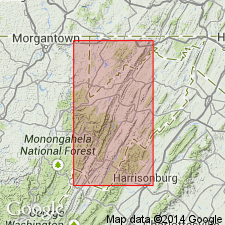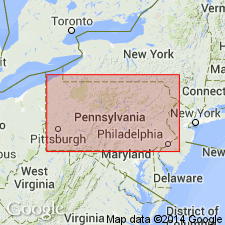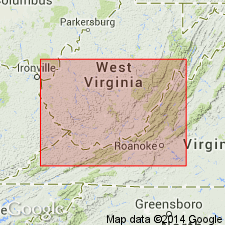
- Usage in publication:
-
- Blizzard Member
- Modifications:
-
- Named
- Dominant lithology:
-
- Sandstone
- Siltstone
- Shale
- AAPG geologic province:
-
- Appalachian basin
Summary:
Blizzard Member here named for stream within 3 km of type section near Judy Gap and assigned to newly named Foreknobs Formation (Greenland Gap Group). Unit consists of interbedded sandstone, siltstone, and some shale with scattered beds of quartz-pebble conglomerate and conglomeratic sandstone. Probably formed in shallow water. 278 ft (85 m) at type section. Ranges to 580 ft (177 m) at Mouth of Seneca. Underlies Pound Sandstone Member of Foreknobs Formation; overlies Briery Gap Sandstone Member of Foreknobs. Age is Late Devonian.
Source: GNU records (USGS DDS-6; Reston GNULEX).

- Usage in publication:
-
- Blizzard Member
- Modifications:
-
- Areal extent
- AAPG geologic province:
-
- Appalachian basin
Summary:
In south-central PA, the Minnehaha Springs Member of the Scherr Formation and the Mallow, Briery Gap, Blizzard, Pound, and Red Lick Members of the Foreknobs Formation of the Greenland Gap Group are recognized. Blizzard Member is composed of brown, green, and gray sandstone, siltstone, and shale. Commonly contains SPINATRYPA SPINOSA, PSEUDOATRYPA DEVONIANA, CYPRICARDELLA BELLASTRIATA, PRODUCTELLA sp., CYRTOSPIRIFER CHEMUNGENSIS, and CYRTOSPIRIFER INERMIS. Fossils indicate sublittoral shelf environments.
Source: GNU records (USGS DDS-6; Reston GNULEX).

- Usage in publication:
-
- Blizzard Member
- Modifications:
-
- Areal extent
- AAPG geologic province:
-
- Appalachian basin
Summary:
The term Foreknobs Formation is not used in the stratigraphic cross section south of Gap Mills, WV. Arbitrary cutoffs are drawn where diagnostic characteristics are lost by facies change. The Mallow Member coarsens upward and also becomes finer grained toward the southwest. Cutoffs of the base of the Mallow Member are drawn between Alleghany and White Sulphur Springs. All sandstone in the Mallow, Briery Gap, Blizzard, and Pound Members is lost southwest of White Sulphur Springs resulting in an arbitrary cutoff of the base of the Foreknobs, which jumps up to the base of the Red Lick Member near Gap Mills. The Red Lick then loses all of its sandstone between Gap Mills and Bluefield.
Source: GNU records (USGS DDS-6; Reston GNULEX).
For more information, please contact Nancy Stamm, Geologic Names Committee Secretary.
Asterisk (*) indicates published by U.S. Geological Survey authors.
"No current usage" (†) implies that a name has been abandoned or has fallen into disuse. Former usage and, if known, replacement name given in parentheses ( ).
Slash (/) indicates name conflicts with nomenclatural guidelines (CSN, 1933; ACSN, 1961, 1970; NACSN, 1983, 2005, 2021). May be explained within brackets ([ ]).

